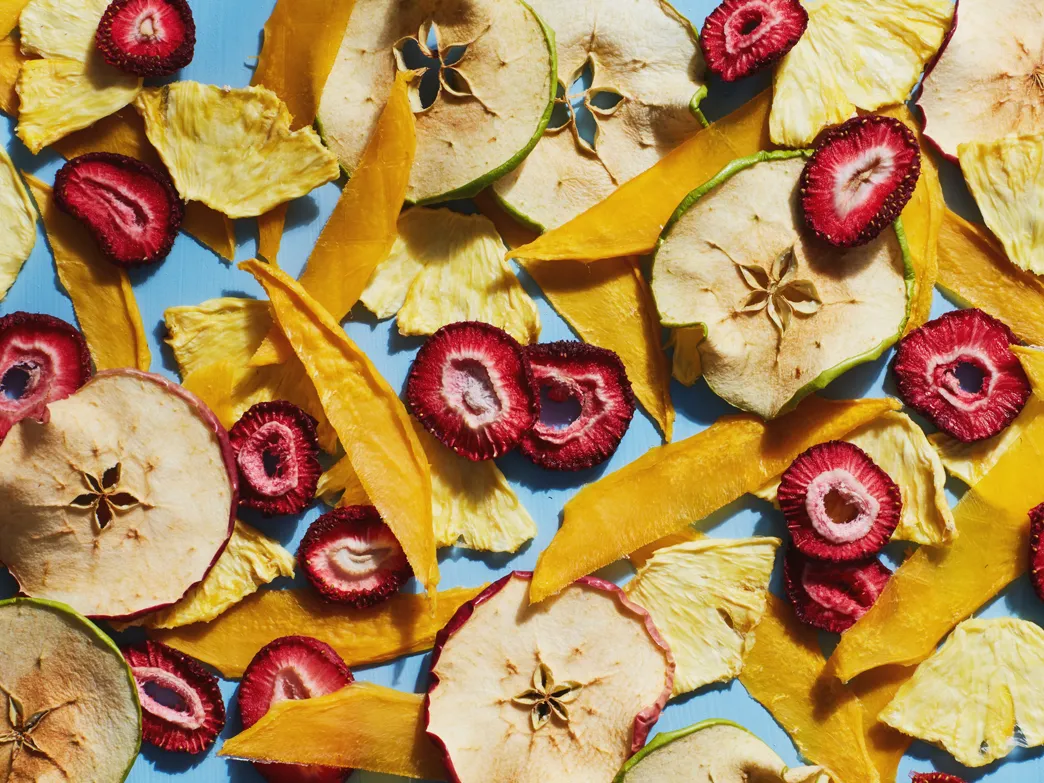Dehydrated fruits can become healthy treats or snacks for children and adults, since we can not only taste them alone, but also accompanied with cereals, granola, smoothies, energy bars, desserts and salads. In addition, they also serve to adjust the acidity of pasta and meat sauces, as well as to replace refined sugar in other recipes.

On the other hand, dehydrated fruits are excellent food reserves to consume in camps, excursions, sports activities, the movies or contingency situations. As well as for snacks, snacks, between meals or whenever you feel like it.
In addition, dehydrating fruits on our own can become a very rewarding task, since it is not a complicated task and allows us to know the origin and content of our food. For this reason, we share with you several easy methods so that you know how to dehydrate fruits at home and without complications.
Fruit dehydration methods
Perhaps the drying of food is one of the best preservation methods that exist, since it respects the essence of the food: its nutrients, smell, flavor and texture. All this without adding chemical additives (at least in non-industrial methods).
Drying or dehydrating simply consists of extracting moisture from food to prevent enzymatic activity and the development of microorganisms. Consequently, foods acquire microbiological and chemical stability.
If the dehydration process is carried out correctly and the lowest possible temperature (40-55 °C) is used, the food will maintain all its nutritional value and organoleptic characteristics (color, texture, flavor and smell). For this reason, most dried fruits retain a high content of fiber and potassium, in addition to other minerals and vitamins.
Although dehydration is an ancient method of food preservation, it has now been greatly refined, thanks to technological advances that allow a healthier and more efficient process. Here we mention the most popular methods for drying food:
- Oven drying or dehydration
- Microwave drying
- Dehydration in the sun
- Electric dryers
- Electric dehydrators
- Solar dryers
- Solar Furnace Dehydrators
Discover other preservation methods and learn how to preserve bread.
Tip: Dehydration concentrates and enhances the flavor of fruit, as well as other foods.
How to dehydrate fruits correctly – Tips
Regardless of the dehydration method you use, there are certain techniques and tricks that will help you achieve the desired result when trying to dehydrate fruits at home. Pay attention and apply them in any circumstance:
Select the best fruits
They must be fresh fruit and have a suitable ripening point. Choose them without bruises or damaged parts.
Cut thin pieces of the same thickness. Thus, they will dehydrate evenly. Remove the seeds and more fibrous parts. You can cut food with a mandolin as it provides clean and exact cuts. On the other hand, very small fruits are best dehydrated whole. If you cut them with a knife, it should be in pieces of 0.5 to 3 cm.
Prepare the fruits before drying them
Although this step is optional, if you do it, you eliminate any enzymes or microorganisms that accelerate the oxidation of the food. To prevent oxidation and improve their final presentation, place them in a bowl with 1 liter of water and 100 ml of lemon for 10-15 minutes.
Each tray or rack you fill should contain the same fruit (if it’s strawberry, only strawberries). Once they are dry, you should let them cool for 60 minutes.
Use only one type of fruit
Use a rack or tray to place the fruits. Arrange the fruit slices side by side, forming a single layer. Do not stack them so that hot air can flow.
Select the best pieces
Choose the quality pieces: they must have the right color and not have any strange appearance.
Once you have chosen the best pieces, supervise them for some additional time. This advice is optional but highly recommended, as it guarantees that the fruit is of quality and lasts longer. To do so, follow these steps:
- Fill a glass jar with the fruit pieces to 2/3 of its capacity.
- Shake the bottle once a day for 7 days. Residual moisture will be evenly distributed among the dry pieces.
- Check if condensation appears in the jar, as this will be a sign that the drying has been incomplete. If this is the case, dry the pieces again using the dehydration method of your choice.
Preservation of dehydrated fruits
Store dried fruit in an airtight glass jar. Once full, place the jar in a dry, clean place, without humidity or sudden changes in temperature. Thus, you avoid rehydration of dehydrated food. You can add oil to some foods such as dried tomatoes, as it has the quality of enhancing the flavor and texture.
Label the jar so that you have control of the date you started keeping it, the fruits will last between 6 months and 1 year. The less water it retains and the fewer external agents intervene, the longer it will last.
Hydrate the fruits when using them
This depends on the case, for example, if a dry food is used in long cooking, you do not need to hydrate it, as it hydrates during cooking. On the contrary, if you use the dehydrated piece in a short cooking or add it to a salad, you should leave it soaking so that it recovers the water lost during dehydration.
This step is optional; you can enjoy the dried fruits without hydrating them.
How to dehydrate fruits in the oven?
Drying fruit in the oven is an easy, hygienic and accessible option for everyone. The only problem with this method is that not all home ovens handle low temperatures (an essential requirement for drying food). In any case, if you follow the following tricks, you will be able to discover how to dehydrate fruits at home and achieve effective results:
- Turn on the oven at a temperature of 40-47 °C. It is useful to know in advance how your oven behaves, since no domestic oven is the same as another. Turn off the oven when it approaches 47ºC. Temperatures ranging from 55-70 ºC destroy nutrients.
- Use a thermometer. It is the best way to control the temperature in a home oven. You just need to set the thermostat to the minimum and, once it reaches 45ºC, put in the tray of fruit that you want to dehydrate.
- Leave the oven door ajar. The opening should be between 5 to 10 cm, so you allow moisture to escape and control the temperature.
- If the oven has a fan, use it. Thus, the constant air current will dry thin slices and small fruits faster.
- Put a fan in front of the oven. You will favor the exit of hot air (this step is optional).
- Turn the fruit pieces over every 20 to 30 minutes to ensure even drying. Use kitchen tongs.
- If the fruit looks dry, it’s done. The total dehydration time of the pieces depends on several factors: the amount of water contained in the fruit, the size of the slice, the temperature of the oven and the level of humidity in the air. However, for reference, an average of 2-4 hours or until they look dry can be calculated.
Once you have them ready you can enjoy some delicious dehydrated fruit chips.
How to dehydrate fruits in the microwave?
If you need to dehydrate a lot of fruit, you will love this method, since it saves you a lot of time. Yes, the microwave offers you an almost immediate result but you must watch the drying, if not the fruit can burn. With that said, simply follow the steps below:
- Select quality fruit. Fresh, at the ideal point of maturation and without obvious abuse.
- Wash it and dry it very well (you can use kitchen paper, the absorbent type).
- Cut it into thin slices. Choose only one type of fruit for each drying batch.
- Arrange the fruit slices on top of a microwave-safe plate(or on top of the microwaves own glass turntable). Distribute them without piling them up.
- Microwave for about 30-45 minutes (time depends on fruit, moisture, and size). Select the defrost function, to prevent it from burning.
- Store the dried fruit in a glass jar or vacuum pack it.
Tip: By hydrating the dried fruit, it recovers its organoleptic qualities.
How to dry fruits in the sun?
The main advantage of dehydrating fruits in the sun is that you will not need any tools other than the environment to achieve it. The disadvantage is that drying loses quality, due to poor hygiene and climate control. Either way, drying fruits in the sun is still an effective method, so if you want to give it a try, follow these steps:
- Wash the fruit thoroughly and dry it very well(use kitchen paper, preferably absorbent).
- Expose the fruit slices to the sun and wind in a slit to let the wind circulate.
- Cover the slices with a thin mosquito net or gauze to keep out insects. It is essential that the fruit receives sun and direct air.
- Turn the pieces over every 12 hours.
- The ambient temperature should be around 29°C.
- If the fruit looks dry, it’s done. It may take 2-5 days to completely dehydrate.
Tip: You can create a screen with chicken wire.
How to dehydrate fruits with a dehydrator?
A dehydrator is a device created exclusively to dry food, in a fully controlled manner. Although acquiring a dehydrator implies having one more device at home, it also brings a long list of advantages that come from its specialized design:
- Avoid climate variability.
- Guarantees hygiene.
- It allows you to choose different textures (crispy, chip, crackers or soft textures).
- It consumes little electricity.
- It has other culinary uses.
- You avoid chemical additives.
- Dry fruits, vegetables, fish and meat.
Although this device offers you advantages, the essential steps to dry food remain the same as always and apply to all dehydrators in general. There are different types of dehydrators on the market: electric, solar or solar oven.



